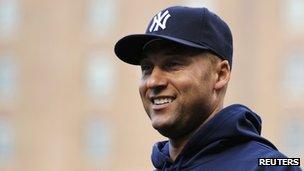What will a white-minority US look like?
- Published

Future generation Americans could look increasingly like bi-racial baseball player Derek Jeter
The US has reached a demographic tipping point, with most babies born now belonging to minority groups.
According to the US Census bureau, black, Hispanic, Asian and mixed-race births made up 50.4% of new arrivals in the year ending in July 2011.
Much of the change is driven by high birth rates among the Hispanic population.
The official notice foreshadows the day, expected in the 2040s, when non-Hispanic whites - like the group that founded America - will be in the minority.
In the new US, what will change - and what might remain the same?
More inclusive America?
The vast majority of young Americans have no qualms about marrying outside their racial and ethnic groups, says Jeffrey Passel, a senior demographer at the Pew Hispanic Center, so a growing proportion of Americans will be biracial.
"The new generation does not see colour, they don't see race," says Ken Gronbach, a demographer and futurist who writes and lectures on marketing and generational change.
"The whole complexion of the US is going to get darker - we're going to look like [bi-racial baseball player] Derek Jeter."
The shift is already apparent in advertising and will become more so, says Howard Buford, president of Prime Access, a multicultural marketing agency in New York.
"A large part of advertising is showing relatable portrayals - 'people like me'," he says. "The hair is becoming darker, the skin is becoming darker. That idea of 'too ethnic' is going away."
The baby on the Downy fabric softener logo for decades was blond-haired and blue-eyed, he notes. Now, the child has dark hair and eyes and olive skin.
Growing Hispanic influence
Spanish slang and rhythm could seep into American English the way African-American speech has already been incorporated through television, film and pop music.
Raul Lopez, president of multicultural marketing research company Phoenix Multicultural, recalls a recent focus group in heavily Hispanic Miami where a group of white girls were speaking - presumably unconsciously - with Spanish vocal inflection and rhythm.
American popular music at least as far back as the early 20th Century has been deeply influenced by African-American music - from jazz and blues through rock'n'roll and hip-hop.
Hispanic tunes - from Caribbean salsa and meringue to Mexico banda and tejano are already heard on urban radio across the country - and could crossover into the suburbs.
For evidence of the Mexican cultural influence on America, see the national popularity of tacos and burritos.
Hispanic culture evolves
Hispanic children born in the US to US-born Hispanic parents could lose their Spanish fluency, reflecting the way, say, the descendents of 20th Century Eastern European Jewish immigrants speak no Yiddish today.
"But they will retain a lot of their culture even if they exercise that culture in English," says Lopez, like lavish "Quinceanera" 15th birthday parties for girls.
Young Hispanic Americans already have pop-cultural programming directed at them.
Mun2 (pronounced "mundos", as in Spanish for "worlds") is a cable television network aimed at young "bicultural" Hispanics, broadcast in both English and Spanish.
Internet radio website Batanga broadcasts Latin genres alongside English-language hip-hop and classic rock.
"They can do both," Lopez says of the new generation of Hispanic Americans. "These people live seamlessly in two worlds - the Hispanic world and the 'general market' US world. They go back and forth and it's not like a switch."
Democratic vote dividend
Young minorities who are coming of age and who vote overwhelmingly Democratic are displacing older white Republican voters in the electorate, says Ruy Teixeira, a demographer at the Center for American Progress.
"In a crude political way you could argue it helps the Democrats, but it puts pressure on the Republicans to make changes," he says. "They cannot cede the minority vote as they have been doing for the last few years."
Struggle for resources
A major proportion of American political debate focuses on social security and health programmes for the elderly, because older voters dominate the electorate.
But like all young people, young minority voters want access to education for themselves and their children, affordable housing, and transportation.
"We're going to be strapped for resources," says Mr Frey.
"The older population has very little personal connection or empathy with this younger, more diverse population."
First Hispanic president?
"I would be amazed if another couple of decades went by and we didn't have a Hispanic president," says Teixeira. "It could be way sooner that that. Who would have guessed the first black president would be as early as 2008?"
A thriving America
Americans should have little fear of widespread racial and ethnic tension, especially true if America's political and community leaders do a good job of reminding people of the country's history as a diverse haven for immigrants, demographers say.
And the population shift is the result of the healthy fertility rates needed to sustain a market economy, says Gronbach. Compare America's 2.06 babies born per women with Italy's (1.4) and Japan's (1.39).
"The best days for America are ahead, not behind us," he says. "Demographics precipitates economics, and the demographics of the US and the demographics of the continent of the Americas is very good."
- Published17 May 2012